“Sentimento del contrario”: Giorgio de Chirico’s Irony and Luigi Pirandello’s Umorismo
Damian Dombrowski Damian Dombrowski Metaphysical Masterpieces 1916–1920: Morandi, Sironi, and Carrà, Issue 4, July 2020https://italianmodernart.org/journal/issues/metaphysical-masterpieces-1916-1920-morandi-sironi-and-carra/
The architectural language and color scheme of de Chirico’s Piazze Italiane is codified in terms of national identity. They reveal the artificial character of the young Italian state, dealing with the precarious hiatus between the pathetic and the ridiculous, and suggesting that the construct named “Kingdom of Italy” was, in reality, insubstantial. De Chirico shared this interest, including its ironic refraction, with Luigi Pirandello who is widely acknowledged as a writer-philosopher, just like de Chirico considered himself a painter-philosopher. Through a comparative analysis of Pirandello’s 1908 essay L’umorismo, and the paintings and writings of de Chirico’s metaphysical period, my paper aims to map out an elective affinity between the painter’s aesthetics and the author’s theoretical viewpoint. With similar diction the two specify an Italian sense of tragedy as a precondition for “humorist” art. Most strikingly, Pirandello’s rejection of logic reads like an anticipation of de Chirico’s theory of the “aspetto spettrale,” made visible by the metaphysical artwork. Hence, this paper is an attempt to enlarge the range of de Chirico’s spiritual sources, often one-sidedly identified with German philosophy (Schopenhauer, Nietzsche), by an Italian element, which may have had an even greater impact on his visual thinking.
Giorgio de Chirico settled in Paris in 1911; it was in the French capital that he fully developed the idea and style of his pittura metafisica. Although he was working among international circles, and associated with leading modernist figures,1 the bulk of his Parisian production is made up of the Piazze d’Italia (1912–14). This extensive series of imaginary architectural squares has a markedly Italian flavor, codified in terms of national identity: the dominant colors are those of the Italian flag, and the public monuments populating the largely empty plazas are reminiscent of those erected as political symbols throughout the country.
But it was anything but unbound admiration that drove de Chirico’s imagination; rather, he was uncovering the artificial character of a national construction. As I have pointed out elsewhere,2 a pungent sense of irony undermined the set-like, tawdry iconography of the new state, with all that trumpery borrowed from France. The Piazze d’Italia reveal how insubstantial the construction of the Regno d’Italia really was, how ridiculous its pathetic symbology, how illusory its foundations. For de Chirico, invoking italianità and deconstructing it were two sides of a medal.
This paper will propose a philosophical essay, “L’Umorismo,” by the novelist and playwright Luigi Pirandello, as a possible, even probable, inspiration for merging the opposite concepts of consent and parody in de Chirico’s “Italian” paintings. The Piazze d’Italia oscillate between affirmation and ironic refraction, as if the former would automatically summon the latter. Hence, de Chirico’s irony must not be mistaken for some kind of comic caricature, satire, or sarcasm whatsoever, for this would mean: commentary and clarification. On the contrary, irony is a device by which the Metaphysical artist visualized the non-sense of the world, and expressed his profound skepticism.
A more precise term for describing the particular relation between intuition and reflection in de Chirico’s paintings is umorismo – at least according to Pirandello’s definition in his important contribution on the subject published in 1908.3 The eventual Nobel laureate’s characterization of what is to be subsumed under this term enables us to come very close to the core of de Chirico’s irony; and by the same token, to the fiery nucleus of his imagination, beyond the mantra-like references to enigma, or disturbance, or alienation, or the unconscious. In other words, I hypothesize a precise, yet hitherto overlooked, philosophical rootedness in de Chirico’s visual thinking – crucial for the most startling period in his career.
The personal acquaintance between artist and writer did not pass altogether unnoticed. In 1924, de Chirico created the stage design for a ballet version of one of Pirandello’s most popular theater plays, La Giara (The Oil Jar, 1916), and illustrations for the accompanying program, which include a portrait drawing of the much-admired dramatist (figure 1).4 De Chirico’s brother, Alberto Savinio, was, in the mid-1920s, among the writers for Pirandello’s Teatro d’Arte, and considered the famous dramatist to be a “father and master” (and himself a “son and disciple”).5 It has been shown that Savinio’s aesthetic ideas were profoundly shaped by Pirandello’s conception of umorismo.6 Although these instances of personal contact date to de Chirico’s second Parisian period (1924–29), during which he met his first wife in the circle of the Teatro d’Arte,7 nothing speaks against the assumption that he knew of Pirandello’s writings much earlier.
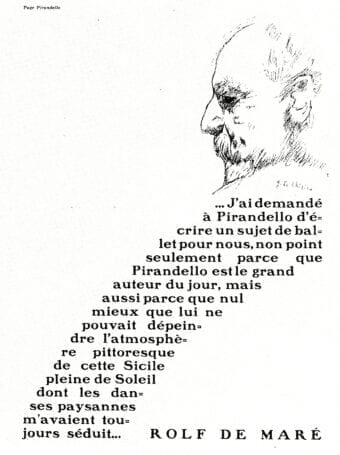
Pirandello’s short stories, novels, and dramas revolve around the problem of identity (one just has to think of Uno, nessuno e centomila [One, No One, and One Hundred Thousand, 1926], where the title already suggests the impossibility of a coherent individual consciousness),8 and not rarely the identity of Italy is at stake. Pirandello looked back to the country’s recent past, to the Risorgimento and the years after the unità; and both these historical moments aroused de Chirico’s strong interest as well. The novella Sua maestà (His Majesty), published in 1915, is a case in point.9 The mayor of a small town in Sicily makes every effort to imitate the looks of King Vittorio Emanuele II. One day, he is notified of an eminent visitor. The government in Rome is sending a delegate, and when the emissary arrives, both sides are amazed, for he too has meticulously adapted the appearance of the Gran Re! They are mirror images of one another, and their encounter produces a series of dazzling episodes.
Among the numerous motifs de Chirico’s imagery shares with Pirandello’s narrative are the Doppelgänger (figures 2–3),10 to which the white shadow or marble bust in his self-portraits alludes, and the iconic presence of Vittorio Emanuele II, whose name is written on the equestrian monument in Nature morte. Turino printanière (Still Life: Turin Spring, 1914; figure 4), and whose facial features appear on the figure with crossed arms in Il ritornante (The Revenant, 1918; figure 5). However, these motifs affect only the surface of things. In order to enter into a deeper layer, and thereby eventually grasp an elective affinity between the painter’s aesthetics and the author’s theoretical viewpoint, it is advisable to first investigate Pirandello’s definition of umorismo.
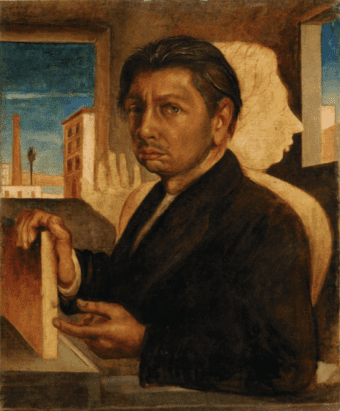
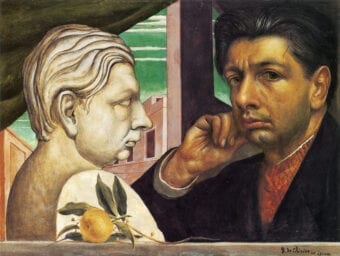

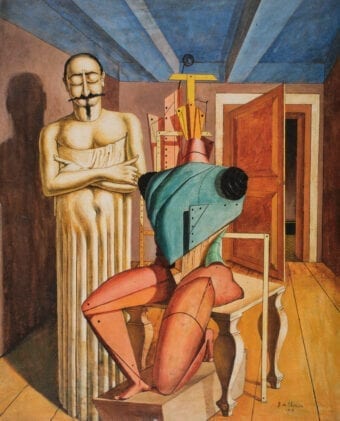
According to his treatise, two categories of artworks must be distinguished: art in general and the opera umoristica. In an ordinary artifact, thinking remains invisible, whereas in art-as-embodiment-of-umorismo, reflection is not hidden but instead becomes an analytic principle, apt to disassemble and decompose the image. From this process results another sensation, which Pirandello calls “sentimento del contrario” (feeling of the opposite).11 The umorista will focus on the “uomo fuori di chiave” (man off-key), “in which a thought cannot originate without the opposite or contrary thought originating at the same time.”12 The disintegration does not derive from eccentricities or personal whim, but is
the necessary and inevitable consequence of the disturbance and disruption which are produced in the organizing movement of images through the work of the active reflection, which evokes an association through contraries: […] every image, every group of images, evokes and attracts contrary ones, and these naturally divide the spirit, which, in its restlessness, is obstinately determined to find or establish the most astonishing relationships between these images.13
From these considerations two apparently irreconcilable yet inseparably interconnected foundations of Pirandello’s aesthetic thought (and, I believe, of de Chirico’s artistic behavior as well) are developed: reflective permeation on the one hand, spontaneity of creative action on the other. Pirandello continues:
Therefore, the reflection of which I speak is not in opposition to the conscious versus the spontaneous; it is a kind of projection of the very activity of the creating imagination: it originates from the mental images like the shadow from a body; it has all the characteristics of ingeniousness or of spontaneous birth; it is in the seed itself of creation, and that which I have called the feeling of the opposites emanates, in fact, from it.14
Where would this “sentimento del contrario” have been more clearly applied, if not in de Chirico’s Portrait of Guillaume Apollinaire (1914; figure 6)? The illogical spontaneity in the assembly of unrelated objects and appearances, their inner contradictions, even the shadow – everything has come into being in this picture. And what deserves to be called “born from phantasm” (as a more proper translation should read)15 if not the manichino that begins to show up in de Chirico’s pictures in 1914, one of the earliest appearances being in La nostalgie du poète (The Nostalgia of the Poet, 1914; figure 7), another “portrait” of Apollinaire?
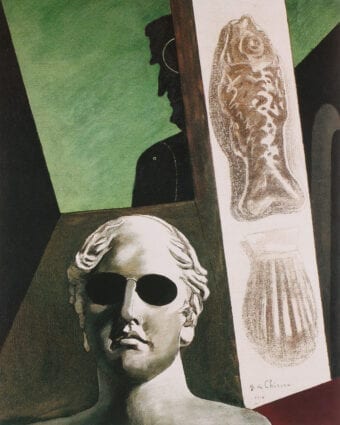

The correlations extend further. According to “L’Umorismo,” the breeding ground of ironic art is necessarily an “innate and inherited melancholy, the sad vicissitudes or a bitter experience of life,” or “a pessimistic or skeptical outlook as a result of study and of meditation on human existence and on the destiny of man.” These sorrowful insights determine “the peculiar temperament known as humoristic.”16 Thus, irony is rooted not in a comical but rather a tragic approach to the world. At this point one is tempted to put Pirandello’s umorismo with de Chirico’s notion of metafisica. For where the former identifies the “innata o ereditata malinconia” as a prerequisite for umorismo, the latter considers the “inveterata gaucherie” (inveterate clumsiness) and “cronica tristezza” (chronic sadness) of Italians as the preconditions for the Metaphysical work of art.17
The painting that can arguably be called the first example of pittura metafisica is L’énigme d’un après-midi d’automne (The Enigma of an Autumn Afternoon, 1910; figure 8). According to de Chirico, it was the result of a “revelation” he had on the Piazza Santa Croce in Florence (where he lived from 1909–11). Looking toward the facade of the Franciscan church, with the Dante Alighieri monument before it, he was befallen by “the strange impression of seeing these things for the first time.”18 Based on this experience, de Chirico would reflect upon artistic creation in general: “The revelation of an artwork (painting or sculpture) can come all of a sudden, in a moment when it is least expected; it can also be generated by the sight of something. […] It belongs to a sort of sensation that is rare and strange.”19

De Chirico’s experience on the Piazza Santa Croce is a well-known episode, and can be read as an elaboration, or exemplification, of Pirandello’s description of those “exceptional moments” when we come upon surprising things within ourselves: “perceptions, reasonings, states of consciousness which really lie beyond the relative limits of our normal and conscious existence.”20 For de Chirico, this transcendent moment was bound to a hypersensitive mind recovering from an intestinal disorder.
Pirandello’s aesthetic ideas and the philosophical foundations of de Chirico’s imagery are closely related – just how closely is especially demonstrated in the closing chapter of “L’Umorismo”: a rejection of logical thought that to some extent reads like an anticipation of de Chirico’s theory of spectrality. The relevant passage in Pirandello’s essay is so illuminating that it deserves to be quoted extensively:
In certain moments of inner silence, in which our soul strips itself of all its habitual fictions and our eyes become sharper and more piercing, we see ourselves in life, and life in itself, as if in a barren and disquieting nakedness; we are seized by a strange impression, as if, in a flash, we could clearly perceive a reality different from the one that we normally perceive, a reality living beyond the reach of human vision, outside the forms of human reason. Very lucidly, then, the texture of daily existence, almost suspended in the void of our inner silence, seems meaningless, devoid of purpose; and that new reality appears to us dreadful in its sternly detached and mysterious crudeness, for all our usual fictitious relationships, both of feelings and images, have separated and disintegrated in it. The inner void expands, surpasses the limits of our body, and becomes a weird emptiness that engulfs us as if time and life had come to a stop, as if our inner silence had plunged into the abyss of mystery. With a supreme effort we then try to recapture the normal consciousness of things, to renew our usual relationships with them, to reassemble our ideas and this habitual sense of living because we now know that they are deceptions which we use in order to survive and that underneath them there is something else which man can face only at the cost of either death or insanity. It was only an instant; but its impression lasts for a long time, as a sort of dizziness which contrasts with the stability, itself so illusory, of things: ambitious or miserable appearance. And life, the small usual life that roams among these appearances, almost seems to us no longer to be real; it is like a mechanical phantasmagoria.21
As has been pointed out by many scholars, de Chirico’s theory of the “aspetto metafisico” (metaphysical sight) or “aspetto spettrale” (spectral sight) of things or persons22 is based on a moment of clairvoyance, comparable to that described by Pirandello, when there is a temporary interruption in the usual flow of logic and memory, that is, in the mental trait d’union that normally serves to categorize things in a reasonable order. Even the most familiar objects – e.g., an artichoke, a book, an egg, a pointing finger, an equestrian monument, and a building, in Nature morte. Turino printanière (Still Life: Turin Spring, 1914; figure 4); or a cricket ball, a rubber glove, a plaster head, archways, and a locomotive, in Le chant d’amour (The Song of Love, 1914; figure 9) – become foreign counterparts when their Metaphysical aspect is revealed; in other words, when they are seen devoid of conventional, logical meaning. De Chirico himself described this mechanism several times;23 the parallels with Pirandello’s theory of umorismo are striking, on a textual as well as a linguistic level.
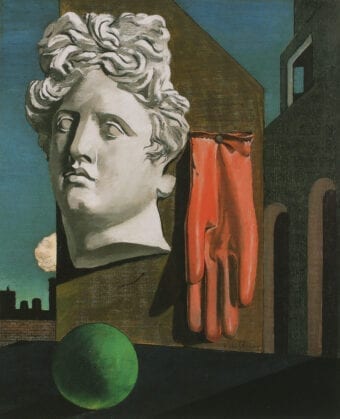
And they may help to deepen our understanding of de Chirico’s Parisian paintings, and even particular motifs. Pirandello’s main concern was the hiatus between the inexorable flow of life and the human effort to arrest it: “The forms in which we seek to stop, to fix in ourselves this constant flux are the concepts, the ideals with which we would like consistently to comply, all the fictions we create for ourselves, the conditions, the state in which we tend to stabilize ourselves.”24 De Chirico’s Metaphysical paintings abound with elements that are, as it were, the imprint of life – elements where life has solidified, most notably in plaster casts like the female torso in L’incertitude du poète (The Uncertainty of the Poet, 1913; figure 10). In J’irai … Le chien de verre (I’ll Be There … The Glass Dog, 1914; figure 11), a statue of Venus has been opened in opposition to the impression of lifelessness, for the hole contains a pumping heart, a powerful symbol of animation. Looking at this picture with Pirandello in mind, one sees the statue as visualizing form in contrast to life: “But within ourselves, in what we call the soul and is life in us, the flux continues, indistinct under the barriers and beyond the limits we impose as a means to fashion a consciousness and a personality for ourselves.”25

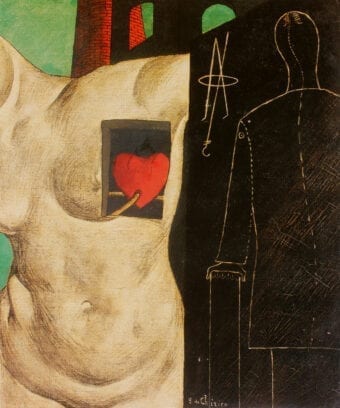
In Le voyage sans fin (The Endless Journey, 1914; figure 12), the ancient statue is not even made of plaster, like the head of Apollo lying in the foreground, but appears to be inhabited by a manichino, the functional substitute for a human figure, or, from a Pirandellian perspective, an illusory victory of form over life. The motif will more or less replace the plaster casts in the next phase of de Chirico’s oeuvre; the method – based on ersatz forms, secondhand but stable – remains the same. It extends to gloves (instead of living hands; see figure 13), pictures within the picture (instead of living nature; figure 14), baking pans (instead of living fish and shell; figure 6),26 statues and puppets (instead of living beings; figures 15–16),27 or even glasses (instead of a living Count of Cavour; figure 17).
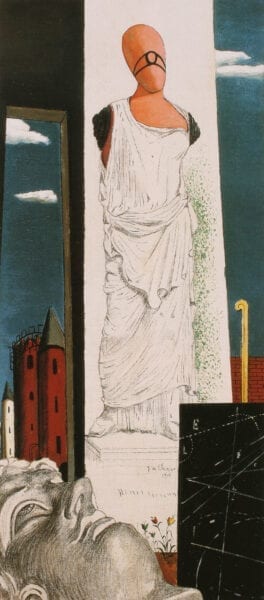



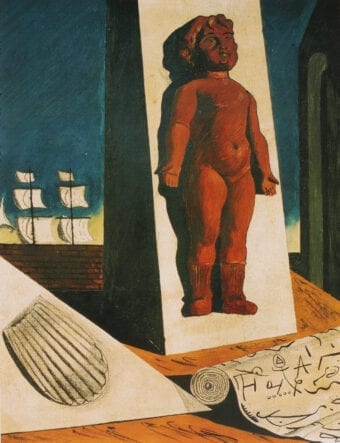

The trademark of de Chirico’s Parisian paintings, the Piazze d’Italia and beyond, is the denial of logical connections between pictorial components. This rejection is entirely in line with Pirandello’s reasoning. In their endless efforts to construct a coherent existence, people are helped by a gift of nature: LOGIC, in capital letters. For this reason, in Pirandello’s explanation, pupils are given Aristotle’s logical writings at an early age, so that children begin to deceive themselves as early as possible.28 For logic creates abstract and reliable ideas, although life is ever-changing; it tends to arrest the continual flux of life, and to declare absolute what is indeed relative.29 To disintegrate logic, and thereby unmask an imagined reality, is the purpose of umorismo,30 for Pirandello just as for de Chirico. “Our knowledge of the world and of ourselves totally lacks the objective value which we usually presume to attribute to it,” wrote Pirandello. “This objective value of reality is a continuous illusory fabrication.”31 From here it is only a small step to de Chirico’s interest in broken objectivity, in the visible world’s ambiguity and instability. In a Pirandellian vein, his poet – or philosopher? – is a dressmaker’s dummy that simulates profound contemplation of a star map (figure 18); yet the head is empty, knowledge of the world – man’s perpetual objective – remains a vanity.

For Pirandello, the human quest for stable forms yields a “costruzione illusoria continua” (ongoing illusory construction), to which humoristic reflection is called upon to decompose. But decomposition is not the ultimate goal of umorista; rather, “through the ridiculousness of the discovery, he will see the serious and painful side; he will disassemble the construction, but not solely to laugh at it; and, instead of feeling disdain, he will rather, in his laughter, feel compassion.”32 This viewpoint may be valid even for de Chirico’s attitude towards the concept of nationhood that Italy tried to adopt so childishly, and it potentially explains, in the Piazze d’Italia, the synchronicity of reverence and unmasking, the latter being occasionally displayed in sexual allusions.33
Scholars tend to trace de Chirico’s visual philosophy quite exclusively to modern thinkers of the North. Friedrich Nietzsche and Arthur Schopenhauer have been cited in this lineage, but also Otto Weininger, Karl Marx, and Sigmund Freud. Wieland Schmied was probably right in stating that scarcely any other artist’s work from the beginning of the century has absorbed so many revolutionary ideas of the modern era.34 However, the flagrant intellectual proximity of de Chirico’s Metaphysical masterpieces to Pirandello’s concept of umorismo should be reason enough to enlarge the range of his spiritual sources with an Italian element that may have had a strong impact on his visual thinking, especially in the Piazze d’Italia.
And, in the long run, it may have had even greater efficacy, for de Chirico’s paintings preserve a degree of Pirandellian umorismo after the breakthrough works of his Paris years. In Ferrara, monuments are no longer rendered as plaster casts or manichini; they are instead built from set squares with the help of rulers and other measuring instruments, synonyms for man’s senseless pursuit of a logical construction of existence (figure 19). Still in the mid-1920s, he identified with the yearning for immobilizing the mobile, for freezing the flow of life, by transforming himself into a marble statue (Self-Portrait Turning into Stone, 1924; figure 20). The “figlio del Caos,” (son of Chaos) as Pirandello called himself, alluding to the name of his birthplace in Sicily,35 found a brilliant interpreter in de Chirico, who so cherished his Greek origins – although this was ironic, for his parents were Italian expatriates. After all, the grande metafisico was no less a great umorista.
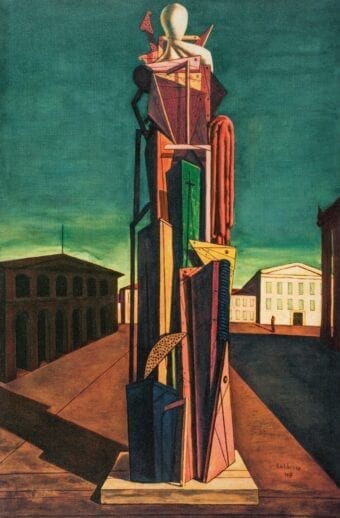
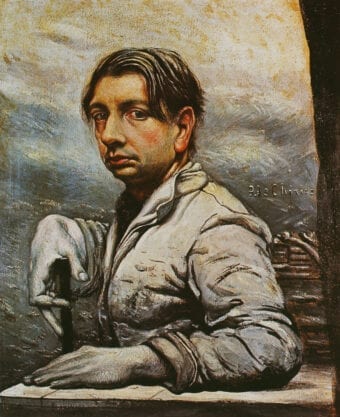
Bibliography
Baldacci, Paolo. De Chirico: The Metaphysical Period, 1888–1919. Boston: Bulfinch Press, 1997.
Benzi, Fabio. Giorgio de Chirico. La vita e l’opera. Milan: la nave di Teseo editore, 2019.
De Chirico, Giorgio. “Que pourrait être la peinture de l’avenir.” Manuscript from the Jean Paulhan collection, 1912. In Scritti/1. Romani e Scritti critici e teorici, 1911–1945, edited by Andrea Cortellessa, 649–52. Milan: Bompiani, 2008.
De Chirico, Giorgio. “Sull’arte metafisica.” Scritti/1. Romani e Scritti critici e teorici, 1911–1945. Edited by Andrea Cortellessa, 286–91. Milan: Bompiani, 2008. Originally published in Valori Plastici 1, nos. 4–5 (April–May 1919): 15–18.
Dombrowski, Damian. “Identität und Ironie in De Chiricos Chant d’amour.” In Kunst auf der Suche nach der Nation. Das Problem der Identität in der italienischen Malerei, Skulptur und Architektur vom Risorgimento bis zum Faschismus, edited by D. Dombrowski, 229–49. Berlin: Lukas Verlag, 2013. Conference proceedings.
Ensabella, Alice, and Stefano Roffi, eds. De Chirico e Savinio. Una mitologia moderna. Cinisello Balsamo: Silvana editoriale, 2019. Exhibition catalogue.
Fagiolo dell’Arco, Maurizio, and Paolo Baldacci. Giorgio de Chirico. Parigi 1924–1929. Dalla nascita del Surrealismo al crollo di Wall Street. Milan: Daverio, 1982.
Jouffroy, Alain. “La metafisica di Giorgio de Chirico.” In Conoscere de Chirico. La vita e l’opera dell’inventore della pittura metafiscia, edited by Isabella Far and Domenico Porzio, 73–98. Milan: Mondadori, 1979.
Mocchi, Nicol Maria. “The Enigma of the Double: Sources and Symbols in Alberto Savinio’s Poetics,” in Alberto Savinio, monographic issue of Italian Modern Art, 2 (July 2019), https://www.italianmodernart.org/journal/articles/the-enigma-of-the-double-sources-and-symbols-in-alberto-savinios-poetics/.
Mocchi, Nicol M. La cultura dei fratelli de Chirico agli albori dell’arte metafisica. Milano e Firenze 1909–1911. Milan: Scalpendi Editore, 2017.
Picozza, Paolo. “Giorgio de Chirico e la nascita della metafisica a Firenze nel 1910.” Metafisica, nos. 7–8, (2007/8): 19–92.
Pirandello, Luigi. Erbe del nostro orto. Milan: Studio Editoriale Lombardo, 1915.
Pirandello, Luigi. L’Umorismo. Edited by Salvatore Guglielmino. Milan: Mondadori, 1992. Originally published in 1908. Translated by Antonio Illiano as On Humour (Chapel Hill: University of North Carolina Press, 1974).
Pirandello, Luigi. Novelle per un anno. Edited by Mario Costanzo, vol. 1, part 1, Scialle nero – La vita nuda – La rallegrata – L’uomo solo – La mosca. Milan: Mondadori, 1996.
Pirandello, Luigi. Novelle per un anno III. La rallegrata. Florence: Bemporad, 1922.
Schmied, Wieland. “Die metaphysische Kunst des Giorgio de Chirico vor dem Hintergrund der deutschen Philosophie.” In De Chirico und sein Schatten. Metaphysische und surrealistische Tendenzen in der Kunst des 20. Jahrhunderts, 41–56. Munich: Prestel, 1989. Originally published in De Chirico. Der Metaphysiker, edited by William Rubin, Wieland Schmied, and Jean Clair, 89–107. Munich: Prestel, 1982. Exhibition catalogue.
Tinterri, Alessandro. Savinio e lo spettacolo. Bologna: il Mulino, 1993.
Tinterri, Alessandro. “Un padre ci vuole. Savinio e Pirandello.” In Savinio e l’Altro, 49–65. Genoa: Il Melangolo, 1999.
Tori, Attilio. “Luigi Pirandello (1867–1936).” In La “Rivista di Firenze.” Una pagina della cultura toscana del Novecento, edited by Emanuele Greco, Francesca Guarducci, and Attilio Tori, 52. Florence: Pacini, 2015. Exhibition catalogue.
Triente, Antonio. “Savinio e Pirandello, umorismo e non.” In I cantieri dell’italianistica. Ricerca, didattica e organizzazione agli inizi del XXI secolo, edited by Beatrice Alfonzetti, Guido Baldassari, and Franco Tomasi, 1–8. Rome: Adi Editore, 2014. Conference proceedings.
How to cite
Damian Dombrowski, “‘Sentimento del contrario’: Giorgio de Chirico’s Irony and Luigi Pirandello’s Umorismo,” in Erica Bernardi, Antonio David Fiore, Caterina Caputo, and Carlotta Castellani (eds.), Metaphysical Masterpieces 1916–1920: Morandi, Sironi, and Carrà, monographic issue of Italian Modern Art, 4 (July 2020), accessed [insert date].
- See the unsurpassed monograph Paolo Baldacci, De Chirico: The Metaphysical Period, 1888–1919 (Boston: Bulfinch Press, 1997), 111–296. See also the comprehensive chapter on the Parisian period in Fabio Benzi, Giorgio de Chirico. La vita e l’opera (Milan: la nave di Teseo editore, 2019), 95–173.
- See Damian Dombrowski, “Identität und Ironie in De Chiricos Chant d’amour,” in Kunst auf der Suche nach der Nation. Das Problem der Identität in der italienischen Malerei, Skulptur und Architektur vom Risorgimento bis zum Faschismus, ed. D. Dombrowski (Berlin: Lukas Verlag, 2013), 229–49.
- Luigi Pirandello, L’Umorismo (Lanciano: R. Carabba, 1908). This essay quotes a later Italian-language edition: L’Umorismo, ed. Salvatore Guglielmino (Milan: Mondadori, 1992). For the translations included here, I relied on the English-language edition On Humour, transl. Antonio Illiano (Chapel Hill: University of North Carolina Press, 1974).
- Beneath the drawing of Pirandello’s profile is a laudatory statement by Rolf de Maré, the director of the Ballets Suédois, who performed La Giara in 1924. See Maurizio Fagiolo dell’Arco and Paolo Baldacci, Giorgio de Chirico. Parigi 1924–1929. Dalla nascita del Surrealismo al crollo di Wall Street (Milan: Daverio, 1982), 149–51.
- Thus reads the personal dedication in Pirandello’s copy of Savinio’s Capitano Ulisse (Captain Odysseus, 1925): “A Luigi Pirandello come figlio e discepolo al padre e al maestro Alberto Savinio.” Quoted in Alessandro Tinterri, Savinio e lo spettacolo (Bologna: il Mulino, 1993), 31. On their relationship, see also Tinterri, “Un padre ci vuole. Savinio e Pirandello,” Savinio e l’Altro (Genoa: Il Melangolo, 1999), 49–65, for the dedication, 54. I am grateful to Nicol Mocchi for sharing her knowledge of Alberto Savinio with me, including bibliographical information.
- Albeit not to the point of complete assimilation. See Antonio Triente, “Savinio e Pirandello, umorismo e non,” in I cantieri dell’italianistica. Ricerca, didattica e organizzazione agli inizi del XXI secolo, ed. Beatrice Alfonzetti, Guido Baldassari, and Franco Tomasi (Rome: Adi Editore, 2014), 1–8. Triente dates Savinio’s “discovery” of Pirandello to the early 1920s (a little arbitrarily, perhaps) given the attention on “L’Umorismo” in that period.
- See Fagiolo dell’Arco and Baldacci, Giorgio de Chirico, 179.
- A sample of some pages of the novel, which was published by Bompiani in 1926, appeared in Rivista di Firenze a year earlier. At this time the journal was mentored by Giorgio Castelfranco; contact with the famous writer was established, it seems, by one of the de Chirico brothers, for they were both close friends of Castelfranco. See Attilio Tori, “Luigi Pirandello (1867–1936),” in La “Rivista di Firenze.” Una pagina della cultura toscana del Novecento, ed. Emanuele Greco, Francesca Guarducci, and Attilio Tori (Florence: Pacini, 2015), 52.
- First published in Luigi Pirandello, Erbe del nostro orto (Milan: Studio Editoriale Lombardo, 1915); reprinted in Luigi Pirandello, Novelle per un anno III. La rallegrata (Florence: Bemporad, 1922). An updated edition is Luigi Pirandello, Novelle per un anno, ed. Mario Costanzo, vol. 1, part 1, Scialle nero – La vita nuda – La rallegrata – L’uomo solo – La mosca (Milan: Mondadori, 2006), 526–42.
- This interest in the Doppelgänger theme was intimately shared by Alberto Savinio. See Nicol Maria Mocchi, “The Enigma of the Double: Sources and Symbols in Alberto Savinio’s Poetics,” in Alberto Savinio, monographic issue of Italian Modern Art, 2 (July 2019), https://www.italianmodernart.org/journal/articles/the-enigma-of-the-double-sources-and-symbols-in-alberto-savinios-poetics/. On the relation between the De Chirico brothers, see Nicol Mocchi, La cultura dei fratelli de Chirico agli albori dell’arte metafisica. Milano e Firenze 1909–1911 (Milan: Scalpendi Editore, 2017); De Chirico e Savinio. Una mitologia moderna, eds. Alice Ensabella and Stefano Roffi (Cinisello Balsamo: Silvana editoriale, 2019).
- “E, d’ordinario, nell’artista, nel momento della concezione, la riflessione si nasconde, resta, per così dire, invisibile; è, quasi, per l’artista una forma del sentimento. […] Ebbene, noi vedremo che nella concezione di ogni opera umoristica, la riflessione non si nasconde, non resta invisibile, non resta cioè una forma del sentimento, quasi uno specchio in cui il sentimento si rimira; ma gli si pone innanzi, da giudice; lo analizza, spassionandosene; ne scomone l’immagine; da questa analisi però, da questa scomposizione, un altro sentimento sorge o spira: quello che potrebbe chiamarsi, e che io difatti chiamo il sentimento del contrario.” Pirandello, L’Umorismo (Milan: Mondadori, 1992), 125–26. “As a rule, in the moment of artistic conception, reflection is hidden and remains, as it were, invisible: in the artist, reflection is almost a form of feeling. […] Now, we shall see that during the conception of all works of humor, reflection is not hidden, it does not remain invisible: it is not, that is, almost a form of feeling or almost a mirror in which feeling contemplates itself: rather, it places itself squarely before the feeling, in a judging attitude, and, detaching itself from it, analyzes it and disassembles its imagery; from this analysis and decomposition, however, there arises or emerges a new feeling which could be called and in fact I call the feeling of the opposite.” On Humour, 112–13.
- Ibid., 124. “Nella sua anormalità, non può esser che amaramente comica la condizione d’un uomo che si trova ad essere sempre quasi fuori di chiave, ad esser a un tempo violin e contrabasso; d’un uomo a cui un pensiero non può nascere, che subito non gliene nasca un altro opposto, contrario.” L’Umorismo, 138–39.
- Pirandello, On Humour, 119. “Questa scompostezza, queste digressioni, queste variazioni non derivano già dal bizzarro arbitrio o dal capriccio degli scrittori, ma sono appunto necessaria e inovviabile conseguenza del turbamento e delle interruzioni del movimento organatore delle immagini per opera della riflessione attiva, la quale suscita un’ associazione per contrarii: le immagini cioè, anziche associate per similazione o per contiguità, si presentano in contrasto: ogni immagine, ogni gruppo d’immagini desta e richiama le contrarie, che naturalmente dividono lo spirito, il quale, irrequieto, s’ostina a trovare o a stabilir tro loro le relazioni più impensate.” L’Umorismo, 132.
- Pirandello, On Humour, 120. “La riflessione, dunque, di cui io parlo, non è un’opposizione del cosciente verso lo spontaneo; è una specie di projezione della stessa attività fantastica: nasce del fantasma, come l’ombra dal corpo; ha tutti I caratteri della ‘ingenuità’ o natività spontanea; è nel germe stesso della creazione, e spira in fatti da essa ciò che ho chiamato il sentimento del contrario.” L’Umorismo, 134.
- In fact, Illiano’s translation of “nasce dal fantasma” as “it originates from the mental image” (see previous note) does not sufficiently transmit the phantasmal dimension of Pirandello’s expression.
- Pirandello, On Humour, 120. “Questo apparirà chiaro quando si pensi che se, indubbiamente, una innata o ereditata malinconia, le tristi vicende, un’amara esperienza della vita, o anche un pessimismo o uno scetticismo acquistino con lo studio e con la considerazione su le sorti dell’umana esistenza, sul destino degli uomini, ecc. possono determinare quella particolar disposizione d’animo che si suol chiamare umoristica.” L’Umorismo, 133.
- Giorgio de Chirico, “Sull’arte metafisica,” Valori Plastici 1, nos. 4–5 (1919): 15–18. I am quoting from Giorgio de Chirico, Scritti/1. Romani e Scritti critici e teorici, 1911–1945, ed. Andrea Cortellessa (Milan: Bompiani, 2008), 286–91. “La nostra inveterata gaucherie e lo sforzo che di continuo dobbiamo assuefarci ad una concezione di leggerezza spirtuale hanno come conseguenza diretta il peso della nostra cronica tristeza.” Ibid., 288.
- Giorgio de Chirico, “Que pourrait être la peinture de l’avenir” (1912), manuscript in the Jean Paulhan Collection. Reprinted in de Chirico, Scritti, 649–652, here, 650. Translation mine. This painting, which always held a special place in de Chirico studies, has recently been subject of a concise and lucid discussion by Benzi, Giorgio de Chirico, 77–80. On its significance for the emergence of Metaphysical art, see more extensively Paolo Picozza, “Giorgio de Chirico e la nascita della metafisica a Firenze nel 1910,” in Metafisica, nos. 7–8, (2007/8): 19–92.
- “La révélation d’une œuvre d’art (peinture ou sculpture) peut naître tout à coup, quand on s’y attend le moins et peut être aussi provoquée par la vue de quelque chose. […] elle appartient à un genre de sensations rares et étranges.” Ibid., 651. Translation mine.
- Pirandello, On Humour, 135. “E tante e tante cose, in certi momenti eccezionali, noi sorprendiamo in noi stessi, percezioni, ragionamenti, stati di coscenza, che son veramente oltre i limiti relative della nostra esistenza normale e cosciente.” L’Umorismo, 152.
- Pirandello, On Humour, 138. “In certi momenti di silenzio interiore, in cui l’anima nostra si spoglia di tutte le finzioni abituali, e gli occhi nostri diventano più acuti e più penetranti, noi vediamo noi stessi nella vita, e in sé stessa la vita, quai in una nudità arida, inquietante; ci sentiamo assaltare da una strana impression, come se, in un baleno, ci si chiarisse una realtà diversa da quella che normalmente percepiamo, una realtà vivente oltre la vista umana, fuori delle forme dell’umana ragione. Lucidissimamente allora la compagine dell’esistenza quotidiana, quasi sospesa nel vuoto di quell nostro silenzio interiore, ci appare priva di senso, priva di scopo; e quella realtà diversa ci appare orrida nella sua crudezza impassibile e misteriosa, poiché tutte le nostre fittizie relazioni consuete di sentimenti e d’immagini si sono scisse e disgregate in essa. Il vuoto interno si allarga, varca i limiti del nostro corpo, diventa vuoto intorno a noi, un vuoto strano, come un arresto del tempo e della vita, come se il nostro silenzio interiore si sprofondasse negli abissi del mistero. Con uno sforzo supremo cerchiamo allora di riacquistar la coscenza normale delle cose, di riallacciar con esse le consuete relazioni, di riconnetter le idee, di risentirici vivi come per l’innanzi, al modo solito. Ma a questa coscenza normale, a queste idee riconnesse, a questo sentimento solito della vita non possiamo più prestar fede, perché sappiamo ormai che sono un nostro inganno per vivere e che sotto c’è qualcos’altro, a cui l’uomo non può affacciarsi, se non a costo di morire o d’impazzire. È stato un attimo; ma dura a lungo in noi l’impressione di esso, come una vertigine, con la quale contrasta la stabilità, pur così vana, delle cose: ambiziose o misere apparenze. La vita, allora, che s’aggira piccolo, solita, fra queste apparenze ci sembra quasi che non sia più per davvero, che sia come una fantasmagoria meccanica.” L’Umorismo, 154–55.
- A concise introduction to the theory of pittura metafisica is the still-recommendable essay by Alain Jouffroy, “La metafisica di Giorgio de Chirico,” in Conoscere de Chirico. La vita e l’opera dell’inventore della pittura metafiscia, ed. Isabella Far and Domenico Porzio (Milan: Mondadori, 1979), 73–98.
- Most comprehensively in de Chirico, “Sull’arte metafisica.”
- Pirandello, On Humour, 137. “La vita è un flusso continuo che noi cerchiamo d’arrestare, di fissare in forme stabili e determinate, dentro e fuori di noi […]. Le forme, in cui cerchiamo d’arrestare, di fissare in noi questo flusso continuo, sono i concetti, sono gli ideali a cui vorremmo serbarci coerenti, tutte le finzioni che ci creiamo, le condizioni, lo stato in cui tendiamo a stabilirci.” L’Umorismo, 153.
- Pirandello, On Humour, 137. “Ma dentro di noi stessi, in ciò che noi chiamiamo anima, e che è la vita in noi, il flusso continua, indistinto, sotti gli argini, oltre i limiti che noi imponiamo, componendoci una coscienza, costruendoci una personalità.” L’Umorismo, 153–54.
- Comparable to the Apollinaire portrait, in the motif of the fish-shaped baking forms, is the oil painting L’arc des échelles noires (The Span of Black Ladders, 1914).
- For the motif of the puppet, see, for instance, the oil painting Le temple fatal (The Fatal Temple, 1914).
- “Ma l’uomo? […] si figura tante cose che ha bisogno di creder vere e di prendere sul serio. L’ajuta in questo una certa macchinetta infernale che la natura volle regalargli, aggiustandogliela dentro, per dargli una prova segnalata della sua benevolenza. […] Aristotile ci scrisse sopra finanche un libro, un leggiadro trattatello che si adotta ancora nelle scuole, perché i fanciulli imparino presto e bene a baloccarcisi. È una pompa a filtro che mette in comunicazione il cervello col cuore. La chiamano LOGICA I signori filosofi.” Pirandello, L’Umorismo, 156. “But man? […] he creates so many things which he needs to believe in and to take seriously. He is helped by a certain devilish little machine that nature chose to give him and to fix inside him as a signal proof of her benevolence. […] Aristotle even wrote a book about it, a graceful little treatise, which is still used in the schools, so that the youngsters may learn early and well how to play with it. It is a kind of filter pump that connects the brain to the heart. LOGIC is what our revered philosophers call it.” On Humour, 139.
- “L’uomo non ha della vita un’idea, una nozione assoluta, bensì un sentimento mutabile e vario, secondo I tempi, i casi, la fortuna. Ora la logica, astraendo dai sentimenti le idee, tende appunto a fissare quel che è mobile, mutabile, fluido; tende a dare un valore assoluto a ciò che è relativo.” Pirandello, L’Umorismo, 157. “Man does not have an absolute idea or conception of life, but rather a feeling that changes and varies depending on the times, the circumstances, and luck. Now logic, by abstracting ideas from emotions, tends precisely to fix what is changeable and fluid; It tends to give an absolute value to what is relative.” On Humour, 140.
- “Ma quest’analisi la fa per noi l’umorista, che si può dar pure l’ufficio di smascherare tutte le vanità […].” Pirandello, L’Umorismo, 150–51. “But it is the humorist who does this analysis for us and who can also take up the task of unmasking all vanities […].” On Humour, 134.
- Pirandello, On Humour, 132. “Manca affatto alla nostra conoscenza del mondo e di noi stessi quel valore obiettivo che comunemente presumiamo di attribuirle. È una costruzione illusoria continua.” L’Umorismo, 147.
- Pirandello, On Humour, 132. “[…]: attraverso il ridicolo di questa scoperta vedrà il lato serio e doloroso; smonterà questa costruzione, ma non per riderne solamente; e in luogo di sdegnarsene, magari, ridendo, compatirà.” L’Umorismo, 148.
- See Dombrowski, “Identität und Ironie,” 244–46.
- Wieland Schmied, “Die metaphysische Kunst des Giorgio de Chirico vor dem Hintergrund der deutschen Philosophie,” in De Chirico und sein Schatten. Metaphysische und surrealistische Tendenzen in der Kunst des 20. Jahrhunderts (Munich: Prestel, 1989), 41–56.
- “Io dunque son figlio del Caos; e non allegoricamente, ma in giusta realtà, perché son nato in una nostra campagna, che trovasi presso ad un intricato bosco, denominato, in forma dialettale, Càvusu dagli abitanti di Girgenti” (Therefore, I am a child of Chaos: and not metaphorically, but in reality, for I was born in a territory of ours which is situated close to a tortuous forest, called Càvasu in the dialect of the residents of Girgenti). Luigi Pirandello in an autobiographical fragment from 1893, published in Nuova Antologia, June 16, 1933. Quoted in Mario Costanzo, “Cronologia della vita e delle opera di Luigi Pirandello,” in Pirandello, Novelle per un anno, xxiii.

